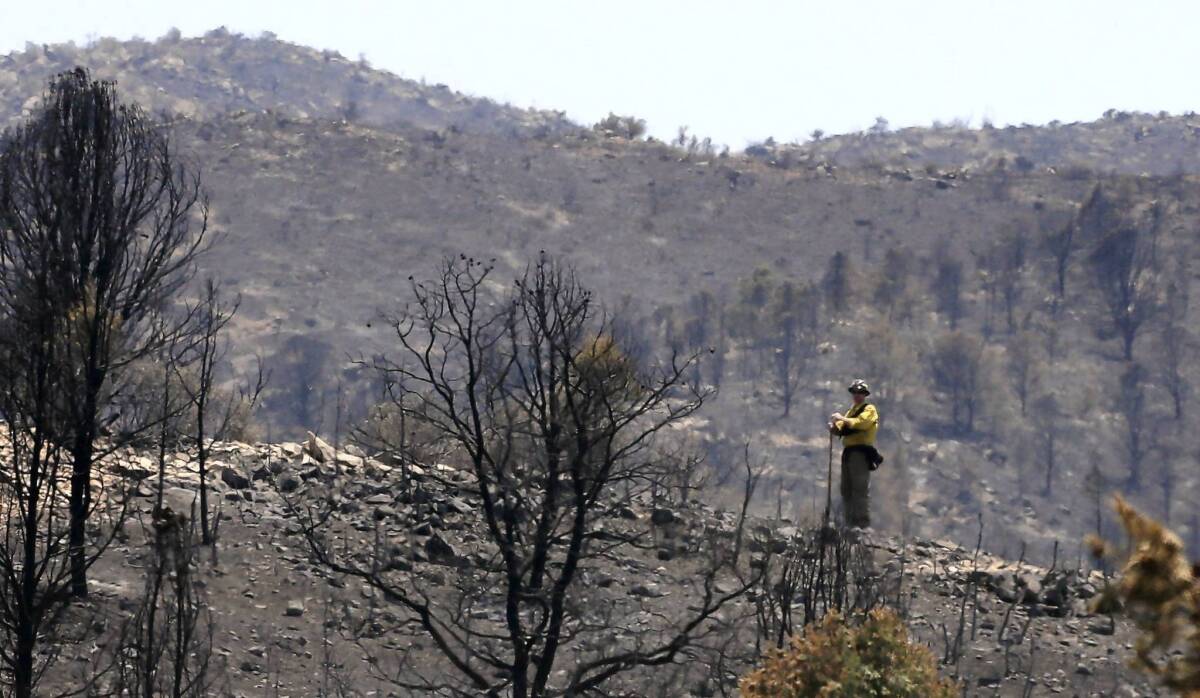19 fallen Arizona firefighters showed courage to the end

- Share via
PRESCOTT, Ariz. — Hours before the Granite Mountain Interagency Hotshots climbed into the parched, craggy hills where they would die, one of them woke his father with a phone call.
“We have a fire in Yarnell,” said Kevin Woyjeck. “It’s big and getting bigger.”
The lightning-sparked wildfire outside the tiny former gold-mining town had spread to 200 acres, sweeping over deep canyons and big boulders, taking fuel from chaparral rich with oils that burn hot and fast.
Still, the 21-year-old Woyjeck, the son of a firefighter, did not sound worried.
Granite Mountain was an experienced crew, led by a supervisor old enough to be Woyjeck’s father — he called the crew his kids — and who was known to turn down missions he didn’t think were safe. The hotshots were supremely fit and spoke with a swagger about their ability to absorb punishment. On workouts they’d sometimes run a mile, then turn around and do 300 sit-ups and 100 pull-ups.
And this wasn’t a huge fire. It was what they call a Type III, not even serious enough to call in one of the meteorologists who deploy on the big blazes that can turn deadly with a turn of the weather.
Later that day, though, the winds would shift suddenly. The sky would darken, the cool-headed supervisor would radio for help and, despite a desperate attempt to use a helicopter to douse the suddenly advancing flames , the Yarnell Hill fire would become one of the deadliest blazes in the history of fighting wildfires.
None of this seemed possible when Woyjeck spoke to his father at 6:45 a.m. June 30. The Prescott-based crew had fought fires across the West, and now it would tackle one in its own backyard.
Woyjeck promised his father he would call that night.
::
As the fire advanced that morning, west of Arizona Highway 89 between Yarnell and Peeples Valley, other members of the hotshots crew, 20 men strong, were texting home about the task ahead.
“I think I’m going to be out here a while on this one,” Andrew Ashcraft, 29, a father of four, wrote to his wife. He added later: “It’s getting really wild out here — Peeples Valley is trying to burn down.”
The crew established a safety zone at a large ranch near Yarnell, authorities said, with a bulldozed path leading to it. If the fire took a nasty turn, they expected to retreat there.
At 8 a.m., Yarnell’s retired fire chief, Peter Andersen, watched from his home in the town’s Glen Ilah subdivision as one of the hotshots’ squarish transport trucks, called buggies, rumbled toward the blaze.
Andersen climbed a hill and saw air tankers drop loads of slurry onto the fire. He figured the crews had it under control.
Then, at 1 p.m., with temperatures in triple digits, came a knock on his door. Authorities were urging residents to evacuate.
“From what?” he said.
He refused.
Just 24 minutes later, hotshot crewman Wade Parker, 22, sent his mother a text.
“We’re on a 500-acre fire in Yarnell,” Parker wrote. “Temps supposed to get up to 116. I gotta pretty good headache. Pray for me.”
Parker was a Prescott native and fireman’s son who had ridden in the back seat of his father’s fire truck as a child. He was engaged to be married Oct. 19.
Like others on the hotshot crew, so named because such teams descend on the hottest part of a fast-moving fire, Parker wore heavy protective gear and lugged 50 pounds of equipment. Temperatures peaked that day at 103 degrees.
At 2:05 p.m., the National Weather Service in Flagstaff called the Yarnell Hill fire dispatch center to warn of an approaching thunderstorm. Prescott got some rain, but not the fire zone.
“We could really use a little rain down here,” Ashcraft texted his family at 3:19.
Eleven minutes later, the weather service sent out another thunderstorm warning.
At 4:04 p.m., Parker sent his mother a photograph from his perch on a rocky ridgeline. Below, a massive wall of gray smoke was racing toward the town.
“This thing is running straight for yarnel. jus starting to evac. you can see fire on the left town on right. DO NOT POST THIS ON FACEBOOK OR ANY OTHER SOCIAL MEDIA DEAL!!!!” He didn’t want to start a panic.
Around this time, Ashcraft’s wife, Juliann, sent him another text. She was worried because she hadn’t heard from him in a while: “Are you sleeping down there?”
No response.
::
Sometime after 4 p.m., as the thunderstorm raged overhead, the wind did two dangerous things. It reversed course and blew north-northeast. It also doubled in speed to 26 miles per hour. Rain evaporated before it hit the earth.
Scrambling across granite hills, among the pinyon pine and thick underbrush, the 19 hotshots were carving a fire break to stop the flames’ surge toward the town.
A 20th crewman, Brendan McDonough, 21, was positioned nearby as a lookout.
By 4:30 p.m., the evacuation order became mandatory in Yarnell. Andersen, the former fire chief, grabbed his cat carriers and managed to herd six of his eight cats inside. Stepping outside his house, he felt the hot wind blowing in his face. “It felt like a convection oven,” he said.
To the west he saw a swirling column of black, ember-spitting smoke. It made him think of an approaching tornado.
The intense wind had “split the fire like a horseshoe,” driving it toward Glen Ilah, Andersen said. In his years fighting fires, he could not remember a fire like this one, which he called “erratic ... crazy ... a freak of nature.”
He fled south in his car down Arizona 89, through miles of smoky haze.
It is unclear how many of the townspeople had joined him in fleeing by then. Firefighters assumed there were holdouts, and it was later learned that some homeowners had indeed stayed.
“There’s always an assumption that people’s lives are in jeopardy,” said Jeff Knotek, a retired Prescott fire captain who has participated in briefings on the fire.
The crew had been fighting the fire from the back on a ridge, but the wind shift apparently put the team directly in its path, officials said. Also, a wind inversion occurred, meaning the wind was being pulled down toward the ground, smothering the firefighters in smoke and creating what Knotek called a “zero-visibility situation.”
Wind gusted at more than 40 miles per hour, pushing the flames ferociously. The fire “came around and hooked them,” Knotek said.
The lookout, McDonough, following procedure, escaped to safety after warning the others. “The lookout said, ‘It’s hot and heavy and I’m out of here,’” said Dick Mangan, a retired fire investigator. “The message to the crew was that they better do something too.”
Wade Parker’s father would later learn that helicopter crews had desperately tried to spot his son’s crew through the thick smoke. Sikorsky choppers dropped water onto the area, but the pilots could only guess where the trapped men might be.
Firefighter Todd Pederson heard the radio traffic. “I could hear the guys trying to get a hold of [reconnaissance] aircraft to direct help from helicopters,” he said. “The guys wanted them to know where they were because they were in trouble.”
Officials have said the men lost radio contact at 4:30 p.m. But Colleen Turbyfill, mother of Granite Hill crew member Travis Turbyfill, said she learned from fire officials that the crew radioed in at 4:47 p.m. to say it was trapped.
Prescott Fire Department spokesman Wade Ward said the crew’s supervisor, Eric Marsh, was “calm, cool and collected” when he relayed the deteriorating situation.
At 4:48 p.m., Colleen Turbyfill said, the crew called back to say the team was dug in. The firefighters were deploying their sleeping bag-like fire shelters, which they are trained to do in less than 20 seconds. It was a desperate measure.
Ward said Marsh, 43, remained composed as he radioed with this news. “They were in a tight spot and everyone knew this was going to be a bitch,” Ward said. “But his voice was very calm: ‘We’re deploying.’”
The firefighters fell silent, lost somewhere beneath a roiling blanket of dark smoke.
By 5:30, the radio traffic was speaking of downed firefighters.
They had been lost for an hour or two when the smoke parted enough for a helicopter crew to spot the bodies. There were 19 of them.
::
The men were found huddled near one another.
The hotshots had grouped together in their shelters, a strategy that might have allowed them to communicate “and give each other confidence that they can survive this,” said Mangan, the retired fire investigator. “The intent is to reflect the radiant heat, and grouping together also helps that.”
Ward observed that “They all stayed together. Nobody ran.”
Some of them were in their shelters, some out. This suggested that they didn’t have time to take cover or that they abandoned the shelters because it was too hot.
An observer from the helicopter and a team of local firefighters found their way to the bodies and kept watch. The bodies were lined up in body bags on the scorched ground and draped with American flags.
Officials debated whether it was possible to remove the bodies by helicopter. It was deemed too risky. Patches of ground still sizzled. In a matter of hours, the fire had spread tenfold.
Through the night, bulldozer crews plowed through hot topsoil, rocks and thick brush to create a path to the bodies. They reached the bodies around 5 a.m. Monday.
Officials worked to identify the bodies, sometimes relying on dental records and identifying marks such as scars and tattoos.
On Wednesday morning, a procession of the fire crew’s buggies, nicknamed Alpha and Beta, were driven down from the hill.
“They smell like fires and smelly guys,” Ward said. “That smell is really affectionate for us in a strange way.”
He added, “It was very sad to see them come back without our friends.”
::
Investigators from around the country have arrived to determine what went wrong.
They will examine dispatch logs, weather records, radio conversations, accounts of witnesses. They will have many questions: Who was in charge? How good was the communication? Was there an order to pull back? When did it come?
They will study the carbon monoxide levels in the fallen firefighters’ blood, which may help determine how long the men survived on the hill.
The Prescott-based hotshots had flown across the West battling wildfires, but this one happened close to home. Five were born in Prescott; two more grew up there. Lloyd Burton, a University of Colorado professor who studies fire, wondered whether that influenced their approach.
“They probably had friends in Yarnell,” he said. “They had close ties to the land and the people who lived there. Maybe this led them to get a little closer to the fire and they may have fought it more aggressively.”
The 19 lost firefighters left behind 11 children, 10 widows and three fiancees. Three were expecting children.
A few, including Kevin Woyjeck, left behind firefighter fathers whose paths they had followed.
“Who was I to tell him he couldn’t do it, when I did?” said Joe Woyjeck, a Los Angeles County fire captain who raised his son in Seal Beach, where the family still lives.
The father had helped the son select the Granite Mountain team. Recently he had been urging Kevin to hop a flight to Los Angeles, to complete his application for a local fire crew. But it was a busy fire season, and his son would reply that he couldn’t leave his men.
“You got to understand, Dad, there’s nobody else.”
christopher.goffard@latimes.com
molly.hennessy-fiske@latimes.com
More to Read
Sign up for Essential California
The most important California stories and recommendations in your inbox every morning.
You may occasionally receive promotional content from the Los Angeles Times.














